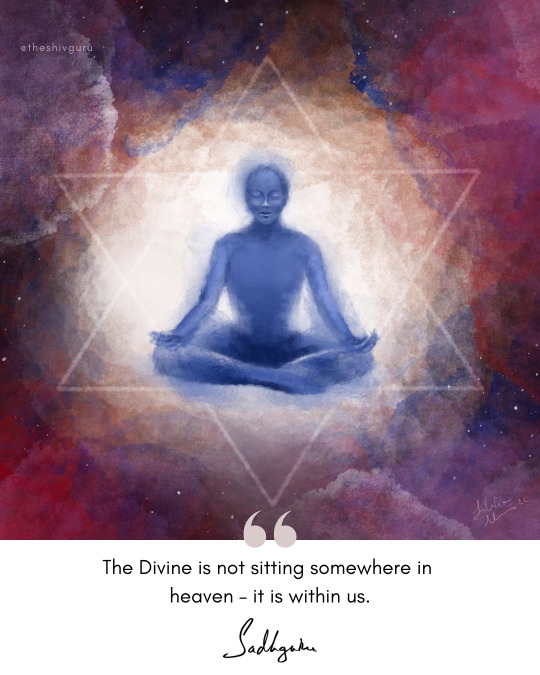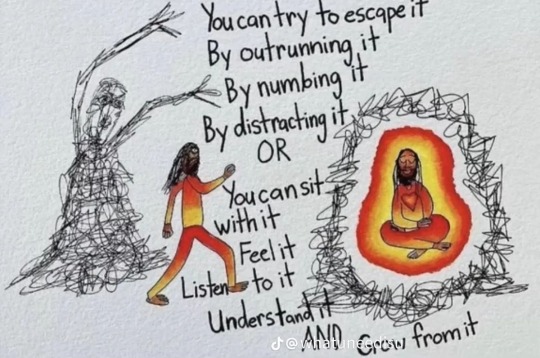#How to meditate
Explore tagged Tumblr posts
Text

working on a different au.
#Imagine teaching a child of chaos#How to meditate#Lmk au#Lmk nezha#lmk sun wukong#lego monkie kid fanart#Lego monkey king#lmk monkey king#Lego monkie kid au#lego monkie kid nezha#lego monkie kid sun wukong#Digital art#Digital artist#artists on tumblr#Artist#Lmk art#lmk fanart
452 notes
·
View notes
Text

#sadhguru#wisdom#consciousness#spirituality#life#yoga#meditation#happiness#quotes#divinity#divine guidance#guru#motivation#life lessons#life quotes#positive quotes#inspiring quotes#quoteoftheday#life quote#beautiful quote#chakras#chakra#artwork#art#illustration#illustrative art#meditative#how to meditate#meditatedaily#spiritual awareness
37 notes
·
View notes
Text
𓍊𓋼 Gassho Meditation: A Basic Overview 𓋼𓍊
What Is Gassho?
Literally translating to “two hands coming together,” Gassho is a form of meditation utilized in many spiritual practices & religions, including Buddhism, Hinduism, and Jainism.
Furthermore, Gassho is the first fundamental pillar of Reiki, and it also functions as a formal greeting!

The Goals of Gassho
The practice of Gassho involves meditating while placing your palms together with your thumbs touching your heart chakra.
The goals of Gassho are to:
Tune out the outside world & clear your mind
Create space to cultivate awareness of and listen to your inner monologue
Awaken the chakras in your hands—that is, the energy centres in the palms of your hands :)
Help cultivate and hold an intention of gratitude
Open your heart
Strengthen your connection to Reiki (if you so choose! You do not have to learn / know Reiki to engage in Gassho 🙃)
The Practice
To engage in Gassho, you create a circuit between the chakras in your hands and your heart. To do Gassho, you…
Get comfortable (meditating is hard when you’re uncomfy!)
Close your eyes
Fold your hands into the prayer position with your thumbs touching your heart chakra
Focus on the space between the palm chakras (alternatively, you can focus on your middle fingers if that’s easier!)
Meditate as long as you can. The goal is to do Gassho for up to 30 minutes, but any time spent is a gift, even if it’s just 3-5 minutes :)
If you find your mind wandering, remember to:
Observe
Gently refocus yourself and remember that it’s normal to get distracted
If it helps, you can press your middle fingers together
Don’t worry or focus on the fact that you’re distracted. It’s normal, and worrying about it will create a spiral. Just gently refocus yourself :)
Remember
Don’t worry about doing it perfectly. You don’t need perfect posture or complete, unbroken focus. Like all meditation, Gassho is a tool you may use to help bring peace of mind and gratitude :)
Happy meditating, my loves! May you all find nothing but balance, healing, and radiance in life 🥰
#my post#witchcraft#pagan#witch#paganism#witchblr#witches#manifestation#meditation#how to meditate#meditative#meditating#Gassho#reiki#reikihealing#reikienergy#reiki therapy#reiki training#spiritual#spirituality#witchy#spiritual journey#spiritual healing#spiritualgrowth#chakras#chakra#energy witchcraft#energy witch#energy work#witch tips
50 notes
·
View notes
Text


The Many Faces of Meditation: Exploring Its Types and Scientific Backing
Meditation is often painted with a broad brush, as if it’s a single practice. But in reality, meditation encompasses a wide range of techniques, each with its unique focus and benefits. Whether you’re looking to relax, enhance focus, or explore spiritual depths, there’s likely a type of meditation that suits your needs.
Below, we���ll dive into some of the most popular forms of meditation, their specific goals, and the science backing their benefits.
1. Mindfulness Meditation
Mindfulness meditation is one of the most popular and accessible forms. It involves paying attention to the present moment nonjudgmentally, often focusing on your breath, bodily sensations, or surroundings.
• What It Does: Helps cultivate awareness and reduces mind-wandering.
• Scientific Backing: A study published in JAMA Internal Medicine (2014) found that mindfulness meditation significantly reduces symptoms of anxiety, depression, and pain. Moreover, research in Social Cognitive and Affective Neuroscience (2011) revealed that regular mindfulness practice increases gray matter density in the brain, particularly in areas associated with learning, memory, and emotional regulation.
2. Transcendental Meditation (TM)
TM involves silently repeating a mantra (a word or phrase) to settle the mind into a state of profound rest and relaxation. It’s highly structured and requires training from certified teachers.
• What It Does: Induces a state of restful alertness and reduces stress.
• Scientific Backing: A meta-analysis in Psychosomatic Medicine (2012) showed that TM can lower blood pressure, making it a valuable tool for cardiovascular health. Additionally, TM has been linked to reduced levels of cortisol (the stress hormone) and improved focus.
3. Loving-Kindness Meditation (Metta)
This practice centers on generating feelings of love and compassion toward yourself and others. It often involves repeating phrases like, “May I be happy,” “May you be safe,” and extending those wishes to all beings.
• What It Does: Boosts empathy, reduces anger, and enhances feelings of social connection.
• Scientific Backing: A study in Psychological Science (2008) showed that practicing loving-kindness meditation increases positive emotions over time, which in turn builds personal resources like resilience and improved relationships.
4. Body Scan Meditation
A type of mindfulness meditation, this practice involves systematically focusing on different parts of your body, noticing sensations, and releasing tension.
• What It Does: Reduces physical stress and enhances body awareness.
• Scientific Backing: Research in Biological Psychology (2010) suggests that body scan meditation significantly decreases cortisol levels and reduces symptoms of chronic pain.
5. Zen Meditation (Zazen)
Rooted in Buddhist tradition, Zen meditation involves seated meditation, focusing on the breath and observing thoughts as they arise and pass without judgment.
• What It Does: Promotes deep mental clarity and insight.
• Scientific Backing: A study in Frontiers in Psychology (2012) found that long-term Zen meditation practitioners showed increased attentional stability and reduced mind-wandering compared to non-meditators.
6. Yoga Nidra (Guided Sleep Meditation)
Often called “yogic sleep,” Yoga Nidra involves guided meditation designed to bring you into a state of deep relaxation between wakefulness and sleep.
• What It Does: Facilitates stress relief and improves sleep quality.
• Scientific Backing: A study in International Journal of Yoga (2013) found that Yoga Nidra reduces anxiety and improves heart rate variability, a key indicator of stress resilience.
7. Focused Attention Meditation
This practice involves concentrating on a single object, sound, or sensation, like a candle flame, mantra, or the rhythm of your breath.
• What It Does: Builds concentration and reduces mind-wandering.
• Scientific Backing: Research in Nature Reviews Neuroscience (2015) highlights that focused attention meditation strengthens the brain’s prefrontal cortex, which plays a key role in decision-making and attention regulation.
8. Movement-Based Meditation (Tai Chi and Qigong)
Unlike still meditation, these involve flowing movements synchronized with the breath.
• What It Does: Combines physical exercise with mental focus, reducing stress and enhancing balance.
• Scientific Backing: Studies in BMC Complementary and Alternative Medicine (2014) indicate that Tai Chi and Qigong reduce symptoms of anxiety, depression, and chronic pain while improving physical health markers like balance and flexibility.
How to Start?
If you’re unsure where to begin, start small. Dedicate 5–10 minutes daily to exploring one practice. Apps like Headspace or Insight Timer can guide you, or you can find countless free resources online.
Meditation isn’t about being perfect or clearing your mind completely; it’s about showing up, being present, and exploring what works for you. As science continues to unravel its benefits, one thing is clear: meditation is a practice that nourishes both the mind and body.
What type of meditation do you practice (or want to try)? Let’s chat in the comments!
Sources
• Goyal, M., et al. (2014). JAMA Internal Medicine.
• Holzel, B. K., et al. (2011). Social Cognitive and Affective Neuroscience.
• Fredrickson, B. L., et al. (2008). Psychological Science.
• Zeidan, F., et al. (2010). Biological Psychology.
#healing#emotions#health and wellness#healthylifestyle#mental health#mental wellness#positive mental attitude#psychology#self care#self growth#self love#self help#self improvement#mental heath support#mental heath awareness#mental help#meditation#meditative#how to meditate#meditatedaily#healthyliving#health & fitness#public health#health tips#healingtips#psychology tips
19 notes
·
View notes
Text

How to Meditate -lights out- fall, hands a-clasped, into instantaneous ecstasy like a shot of heroin or morphine, the gland inside of my brain discharging the good glad fluid (Holy Fluid) as i hap-down and hold all my body parts down to a deadstop trance-Healing all my sicknesses-erasing all-not even the shred of a "I-hope-you" or a Loony Balloon left in it, but the mind blank, serene, thoughtless. When a thought comes a-springing from afar with its held- forth figure of image, you spoof it out, you spuff it off, you fake it, and it fades, and thought never comes-and with joy you realize for the first time "thinking's just like not thinking- So I don't have to think any more"
[Jack Kerouac]
27 notes
·
View notes
Text

Spiritual discipline is what awakens us to divine reality, not belief.
Gnosis signifies knowledge from experience. Gnosticism, as a field of study, pertains to all the ancient schools of mysteries from both East and West, whose scriptures encompass the practical science of awakening consciousness. Gnosis is not isolated to the first Christians, but permeates all times, cultures, and spaces, for while consciousness is universal, the means of expressing such experiential wisdom of the divine is temporal and idiosyncratic to the language, mentality, and needs of a particular society.
Gnosis is what we have verified through experience and experimentation, predicated upon practical methods and personal effort. It is never the product of a belief system, of adopting a religious or mystical attitude, demeanor, or behavior. It is never achieved through attendance, adherence to, or acceptance from a group, by believing in doctrine or creed. It is the flowering and natural unfolding of the soul, which is created and developed when the proper causes and conditions have been met.
Just as there are laws that govern the physical universe, so too are there spiritual laws, causes, and methods to originate the soul: the awakening of the consciousness.
Therefore, the Greek term γνῶσις gnosis is synonymous with genuine faith. Faith has nothing to do with belief, with accepting or rejecting a concept in the mind or upholding a sentiment in the heart. Faith is what we know from facts, from witnessing and understanding reality. Belief takes no effort to foster or develop, whereas the awakening of consciousness and divine experience requires tremendous discipline and the application of spiritual works.
Read or listen to the entirety of this article:
#gnosticism#gnosis#gnostic#chicago gnosis#samael aun weor#gnostic academy of chicago#gnostic tradition#gnostics#gnostic teachings#gnostic bible#gnostical#gnostic christianity#gnostic gospels#spirituality#awakening#meditation#how to meditate#meditation podcasts#spiritual podcasts#spiritual podcast#spiritual exercises#spiritual life#spiritual path#spiritual growth#spiritual journey#spiritual development#spiritual awakening#spiritual disciplines#spiritual enlightenment#spiritualgrowth
72 notes
·
View notes
Text
Meditation used to be a practice that always confounded me, if I'm being honest. I would set a timer, close my eyes, focus on breathing fully & naturally through my nose, and it would feel like I'm attempting to stop a speeding train. My body would *fight* me, going "you can't stop, you have shit to do, you have things to worry about, how long as it been, surely the timer is getting close to being done, maybe you should check." Practically vibrating in my seat. My eyes would twitch. My body would itch. I'd literally be able to feel my heart squirming uncomfortably in my chest on every inhale. Every cell in my body would want me to stop, and prior to the last few months, I absolutely would have stopped!
Instead, I pushed through it. Insisted on holding the brakes down until I fully stopped, no matter how much the train wanted to keep going. I'd ask myself "why am I so uncomfortable" and start "scanning" my body, going through each part and intentionally relaxing it.
As this process goes on, eventually the breathing pattern stops feeling forced. The air begins to feel much like a drink of water when I'm thirsty, nourishing me, and it feels *good.* My thoughts happen, but I'm only observing them. I watch the lights & patterns on the back of my eyelids, no longer feeling my heart pounding against my chest, and I begin to feel an odd, almost... serene sensation above my eyes. As if a heavenly room opened up in my brain; where observations, ideas, and more come to me without much effort at all. It feels almost as if you're on the very edge of sleeping, without falling asleep. Before I knew it, the timer was going off. That's when it clicked. That's the meditative state I've been looking for.
Ever since I've been practicing it more and more. It's never anything long; I started with ten minutes, then fifteen, and I did twenty for awhile. It doesn't sound like a lot, but when you're sitting with your eyes closed, doing nothing, it can feel like forever (before you hit that meditative state, that is). Fifteen minutes is my sweet spot now, and by simply remembering the feeling of that meditative state, I'm able to reach it pretty quickly in those fifteen minutes. Before, i would spend most of the time trying to get there, but it's gotten much easier, and I almost always feel so much more clear and calm afterwards.
So yeah. If meditation has ever been a problem for you, just know that if you haven't practiced it, you're going to be stopping a moving train when you try. You need to keep holding down the brakes until it stops, or it will just keep accelerating. It'll be uncomfortable, and you'll need to learn to sit with the discomfort, feel it, and let it pass. What I found beyond that is 100% worth it

55 notes
·
View notes
Text

#meditation#scream#coping#coping mechanism#coping methods#2010s tumblr#live laugh girlblog#female rage#girlhood#my girlblog#girlblog is my art#girlblogging#this is a girlblog#zen#yoga#yogi#meditative#how to meditate#girl things#girlblog#city girls#satc#carrie bradshaw
14 notes
·
View notes
Note
how to meditate a easy way?
oh, hi!
Meditation, in general, is really easy!
You have to lay down in a comfortable position, or if you want, you can sit on the ground or in a yoga position that you like.You can put some music on, light up some candles, and set up a mood for you to relax in.
Concentrate on your breathing; I usually do 4 seconds in, 4 seconds out, and repeat.
After a while, you will enter a relaxing state, and your mind will automatically shift to think and visualize other things. In a deep state of meditation, you can feel your body go numb in a good way.
Meditation is as simple as this: you can concentrate on other things other than your breathing to start the meditation, but concentrating on the breathing or doing breathing exercises helps us calm the body and mind and can be helpful for the everyday basics.
#journal#manifestation#manifestation method#spiritual development#manifesation#explain the method#manifesting#shifting methods#loa methods#explained#how to meditate#meditatedaily#meditative#meditation#breathingtechniques#shifters#shifting motivation#coronavirus
74 notes
·
View notes
Text

Trying to meditate more,, but it is honestly so hard with ADHD 😵💫
I think my record this month is like 8 minutes to be honest
But every time I meditate for more than 10 minutes, it’s like the craziest experience,
once I was meditating and i got so extremely dizzy that I had to stop
It felt like I was literally falling through the air I had to wake myself up
Any tips?
#void meditation#how to meditate#meditation#breathing exercises#yogainspiration#yoga#yogi#hinduism#void state#astral projection#behind her eyes#guided meditation#relaxation#adhd#samadhi#dhyana#pranayama
9 notes
·
View notes
Text
How to Prepare Yourself for Meditation
Many start meditation with enthusiasm but give up soon. Why? Because true meditation requires preparation, just like an athlete trains before a race.
Hindu sages knew this well. In Ashtanga Yoga, meditation is only the seventh step toward enlightenment! Swami Sivananda used to ask his disciples, “Have you mastered the first six steps?” before expecting success in meditation.
Here’s how to build the right foundation for meditation:
Yama (Self-Restraint)
Practice Ahimsa (Non-violence) – A calm mind is key.
Be truthful and honest in all aspects of life.
Avoid stealing, greed, and attachments to material possessions.
Control desires, including sensual cravings, for mental purity.
Niyama (Disciplined Habits)
Maintain cleanliness (inside and out).
Be content with what you have.
Practice austerity – learn to embrace discipline.
Read spiritual texts instead of distractions.
Surrender to God to release ego and stress.
Moderation is Key!
Even for non-spiritual meditation, balance is essential:
Eat Sattvik food – mild, vegetarian, and nutritious.
Sleep well – 6-8 hours, no oversleeping.
Limit distractions – TV, music, social media in moderation.
The more you follow these principles, the deeper your meditation will be! Are you ready to take your practice to the next level?

#blogger#blogging#india#blogs#blog#tumblog#my writing#reading#hindu#meditation#literature#meditative#how to meditate#meditatedaily#spiritual healing#spirituality#spiritual awakening#spiritual journey#spiritualgrowth
6 notes
·
View notes
Text
Apply in your own experience....
youtube
Whatever you aware of, you are not it. You are that which is aware.
Awareness itself - One without a second.
Video shorts:- Swami Sarvapriyananda
#advaita#nonduality#spiritual#spirituality#yoga#meditation#hinduism#freedom#self inquiry#peace#swami sarvapriyananda#hinduculture#knowthyself#know thyself#self realization#self aware#self reflection#awareness#contemplating life#consciousness#ramana maharshi#nisargadatta#eckhart tolle#who am i?#who am i#moksha#meditateonthis#meditatedaily#how to meditate#how to be happy
49 notes
·
View notes
Text
Meditation - day 29 of 180
I have been meditating every day for almost a month. My goal is to meditate everyday for half a year. Here is my journey so far.
I started of with only ten minute meditations. Every twentieth day I will increase the meditation length with two minutes and thirty seconds so that by the end of the six months I will reach a total of thirty minutes.
I had a hard time to meditate in the beginning as I was not very used to it. I could not meditate without checking the time and it was hard to let go of throughts. I must admit that it is still very hard to meditate but I have seen some improvements.
The main thing is that I feel much more calm. Before I could get quite stressed with meditating actually. I got stressed by not knowing things, not knowing when time was up or not knowing where the meditation would take me. Now it is easier to calm myself with the knowledge that the meditation is in fact only 12.5 minutes long.
I also find myself to be more in tune with nature. I have always been quite grounded as a person but meditation has made this feeling deeper. I want to be in nature more often and I can see myself as a part of it much more.
The main reason to why I started meditating more seriously was spiritual communication. I figured that meditation would be a great add on to my practice as spirits seem to be a great "asset" in witchcraft. Some things has happened during and since meditation that make me belive that this has also improved. Mainly it is some thoughts that hasn't felt like mine or incoherent sentences when waking up.
It makes me happy to see such an improvement in meditation after only twenty days. Therefore I want to keep this practice going for a really long time and I feel confident that my life will change for the better in terms of my own well being but also in spirit communication and alignment with nature.
#witchcraft#magick#witch community#witch practice#witchblr#witchy#spirituality#books#meditation#meditative#how to meditate#mindfulness#gratitude#energy#energy work#shadow work#intuition#healing journey#self discovery#spiritual journey#challange#magick spells#occult#witch#witchery
3 notes
·
View notes
Text

Finding balance in futuristic world.
Balance is not just about equilibrium; it's about harmony. It's about integrating different aspects of our lives - technology, nature, work, leisure, mind, and body - into a unified whole. It's about acknowledging the pace of progress while also appreciating the timeless beauty of the natural world.
#illustration#digital illustration#manga#aestheitcs#art#anime#anime fanart#black art#beautiful#artists on tumblr#ai#digital art#robots#robot#meditation#mental health#social media#how to meditate#balance#harmony#unity#lol#ai artist#ai art#nature#naturecore
75 notes
·
View notes
Text

Un OMI al giorno
#psychiartist#psychiatry#psychology#psychic#daily meditation#how to meditate#meditative#meditation#pensieri#poems and fragments#poem#poetry#amore#love#mental illness#dear diary#poems on tumblr#poesia#yogainspiration#yogaposes#yoga#yogadaily#bookblr#bookbookbook#books and reading#bookworm#books#booklr#library#litterature
3 notes
·
View notes
Text

#ambitious women#beautiful women#beauty#glow society#the glow society#fit beauty#health#self love#self improvement#self care#Instagram#meditation#meditative#how to meditate#meditating buddha painting#black girl moodboard#self development#women’s health#healthy food#health and wellness#boss women#womens workout routines#fit girls#tumblr girls#becoming that girl#keep calm#calmness#calm#calmmusic#calming sounds
4 notes
·
View notes